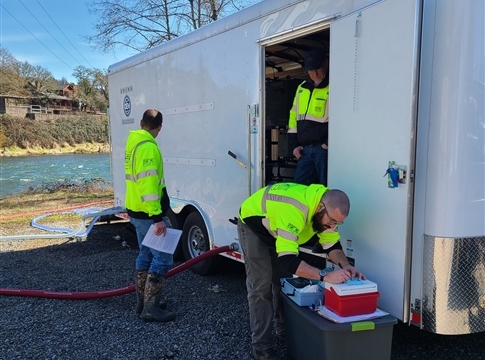Related News
Related News
-
EWEB Sets 2026 Budget and Rates, Advances Evaluation of McKenzie Valley Service Territory Realignment
Taken together, the 2026 budget and rate adjustments and the territory-realignment evaluation reflect EWEB’s dedication to responsible financial stewardship, modern, resilient utility infrastructure, and thoughtful planning for the future.
Find Out More -
Let's Talk Turkey. Is your family ready for winter?
We're heading into the holidays, but that also means snow, ice, and not-so-nice weather might be in the forecast. Here are some tips to prepare in advance.
Find Out More -
EWEB Hosts Annual Spill Drill to Protect McKenzie River
EWEB led emergency responders in its annual “spill drill” on the McKenzie River on Wednesday, Oct. 15, at the Trail Bridge Campground.
Find Out More -
A day in the life: Monitoring water quality throughout the McKenzie Watershed
Follow Senior Environmental Specialist David Donahue as he collects water quality samples from throughout the watershed as part of EWEB's early warning system for threats to Eugene's drinking water.
Find Out More -
EWEB Partners with Eugene School District 4J to Celebrate New Kennedy Middle School Emergency Water Station Site
Hundreds of attendees practiced filling up water containers at Saturday's demonstration event.
Find Out More -
Electric Projects underway in North & South Eugene
Underground lines and disaster-resilient power poles are part of EWEB’s infrastructure upgrade near Eugene’s largest natural resource area.
Find Out More -
Quartz Creek: Setting the Stage for Floodplain Restoration
The project resets the floodplain along 1.8 miles of a formerly channelized creek to improve water quality, fish habitat and natural disaster resiliency.
Find Out More -
Pure Water Partners: 5 Years of Regeneration
As EWEB and the Pure Water Partners observe the fifth anniversary of the Holiday Farm Fire, we celebrate major milestones in the watershed's recovery and check back in with PWP landowners who still have a lot of work ahead as they continue to rebuild their lives.
Find Out More -
Join the Pledge to Prepare
When you think about getting ready for an emergency, you probably have questions. You aren't alone. Preparing for emergencies can be overwhelming, which is why EWEB has put together a 12-month program to help you and your family get two weeks ready.
Find Out More -
You can’t predict the next disaster, but you can prepare
The earthquake lasted less than a minute. But now the power’s out. The tap runs dry. Cell service is spotty. Would you be ready?
Find Out More -
EWEB Celebrates Operators on the 75th Anniversary of the Hayden Bridge Filtration Plant
Learn more about the Water Treatment Plant Operators who have kept the Hayden Bridge Filtration Plant running for the last 75 years.
Find Out More -
NASA partners with EWEB to assess wildfire impacts to drinking water
NASA's Earth Information Center shares a new video detailing how EWEB's Drinking Water Source Protection work is advising new research tools
Find Out More -
EWEB prepares for wildfire season with risk mitigation measures
EWEB is building a more resilient electric system to weather various types of disasters, from wildfire to winter storms.
Find Out More -
EWEB environmental specialist wins prestigious awards for publication
Article recounting EWEB’s efforts to protect the McKenzie River after Holiday Farm Fire earns national recognition
Find Out More -
Last Call for EWEB/Lane County Septic Grants
Holiday Farm Fire recovery program now eligible for businesses, residential property owners who purchased post-fire, to cover inspection costs and new construction
Find Out More - Show More
New water treatment trailer improves EWEB’s emergency response abilities
March 22, 2023 • EWEB Communications Team

The Eugene Water & Electric Board (EWEB) is expanding its capacity to provide water to customers in case of an emergency.
The newest addition is a state-of-the-art water treatment trailer paid for using a grant from the State Preparedness and Incident Response Program (SPIRE).
An example of a large-scale disaster would be the subduction zone earthquake which could affect the McKenzie River, disrupt the water treatment plant or damage the 800 miles of distribution pipes that delivers water to Eugene homes and businesses.
This week, EWEB tested the new water trailer, which uses reverse osmosis – a process that uses high pressure to push water through a membrane – to filter out contaminants.
“Staff will begin water quality testing and training of additional staff with a mind towards improving procedures and equipment, if necessary,” said Hayden Bridge Water Treatment Plant Supervisor Ray Leipold.
EWEB has one other water treatment trailer and three mobile water distribution trailers. The treatment trailers function as drinking water treatment plants on wheels in case an emergency takes EWEB’s Hayden Bridge Treatment Plant offline. These trailers can park at almost any water source and can treat up to 144,000 gallons of fresh water per day. These mobile treatment systems are self-contained and deployable to support Eugene or another regional utility in need.
Permanent emergency water stations
In the past few years, EWEB also has built permanent emergency water stations that will be available if a disaster strikes. Unlike the water treatment trailer, these stations are permanently located at sites throughout Eugene and they provide and distribute untreated groundwater to customers, who will then need to disinfect the water before using it.
EWEB inaugurated two of these permanent emergency water stations last year – one at the Lane County Event Center and another at the Sheldon Community Center. EWEB is in the planning and design stage of building two additional water stations near Churchill High School and near Roosevelt Middle School.
At these permanent stations, underground wells extend more than 100 feet below the surface. Water is pumped up from underground and distributed via pipes and nozzles, where people can fill up jugs of water. The stations are designed to provide each person with two gallons of untreated water per day.

